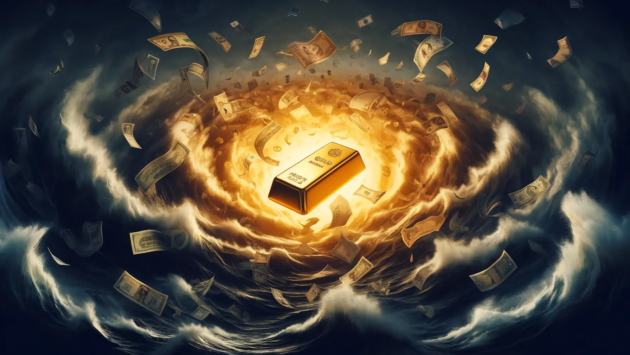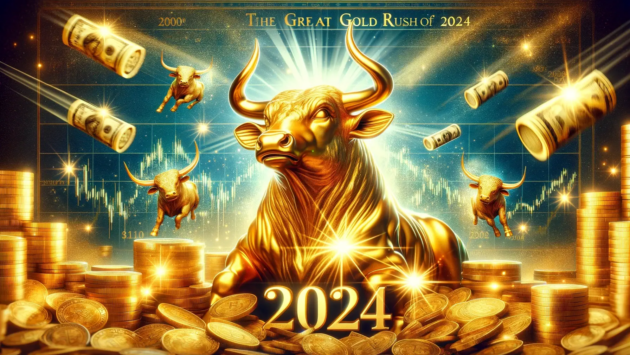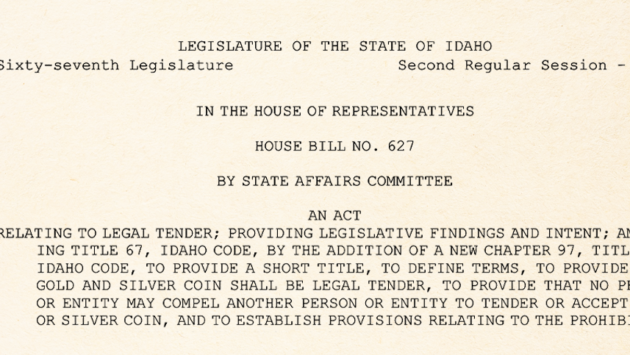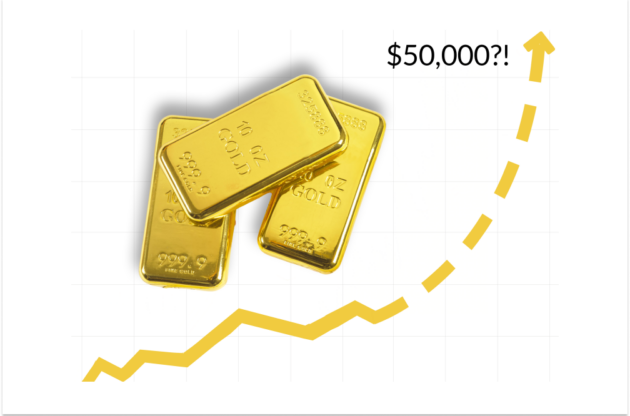
Gold rallied to $2,041.30 an ounce in mid-April — hitting its second-highest price on record.
And if the flood of recent forecasts from high-profile analysts and experts are accurate, right now may be the best time in US history to own physical gold.
Barron’s says gold’s price is hovering “near its all-time high — and the rally might not stop there.”
Goldman Sachs analysts forecast a rally to “an all-time high of $2,050” in 2023.
And Bank of America analysts say gold prices could hit a record-setting $2,200 an ounce in Q4.
However, other analysts believe these forecasts fall short of what’s possible.
Swiss Asia Capital’s managing director and chief investment officer, Juerg Kiener, believes recession fears could push the price of gold to as high as $4,000 sometime next year.
Rich Dad Poor Dad author Robert Kiyosaki says a crash is coming and tweeted “2025 gold at $5,000.”
And Jim Rickards, former advisor to the DOD and CIA (and possibly the world’s foremost expert on gold’s price) said an eventual “$10,000 per troy ounce is not pie in the sky.”
Yet, plenty of analysts believe even those astonishing estimates are too conservative.
On April 9th, 2023, financial researchers and publishers of the Market Intelligence Report at MunKnee.com posted forecasts from 89 analysts, experts and pundits.
All of them expect gold to rise above at least $3,000.
Master analyst Frank Barbera forecasts a 10- to 15-year gold bull run with a shocking price target of $20,000.
And “Mr. Gold” Jim Sinclair — famous for his stunningly accurate gold price forecasts in the 1980s — sees gold heading all the way to a whopping $50,000 by 2025.
Why so many sky-high forecasts from so many high-profile analysts?
On January 4th, we published a partial list of catalysts we believe could create a once-in-a-generation growth opportunity in the coming weeks and months.
Since then, global economic uncertainty has only increased. And multiple strong catalysts for a massive potential gold rally are happening at the same time, including…
- Persistent high inflation
- Weakening of the US dollar’s purchasing power
- Loss of confidence in the US dollar
- Aggressive de-dollarization efforts by Brazil, China, India and South Africa (BRICS)
- Colossal gold purchases by global central banks
- Fallout from the recent banking crisis
- Growing recession fears
- Retail gold investors rushing to help protect their financial futures
And more.
“In other words,” says Jeff Christian, founder and managing partner of commodities consulting firm CPM Group, “it’s messy out there, and that mess has the potential over time to cause hiccups across the world. Those things will be good for gold.”
The list of potential catalysts is long.
But from where I’m sitting…
Two of the biggest “hiccups” that will “be good for gold” may be…
Persistent inflation and erosion of the dollar’s purchasing power.
Despite the Fed’s aggressive rate hikes, inflation is still high. And the US dollar continues to shed its purchasing power.
In fact, just in 2023 — from January 1st, 2023, to today, April 18th, 2023 — the dollar has already lost 1.8% in purchasing power. Meanwhile gold has risen 8.5%. And if the so-called “lower” 5% inflation rate continues, you will lose 50% of the purchasing power of your dollar in 14 years.
This continued loss of purchasing power has weakened confidence in the US dollar. The loss of confidence is spreading worldwide. And the dollar’s status as the world’s reserve currency is under fire.
As you may already know, Brazil, Russia, India and South Africa (BRICS) are working together to end the dollar’s reserve currency status. And Argentina, Turkey, Indonesia, Iran, Mexico, Saudi Arabia, Egypt and the United Arab Emirates may soon join the BRICS de-dollarization coalition.
And since gold tends to rise historically as the dollar falls…
This aggressive global economic shift may put even more downward pressure on the dollar and upward pressure on gold’s price.
Perhaps this is one of the reasons why many of these central banks also have been increasing their gold reserves by colossal amounts… and fast.
According to World Gold Council (WGC) data, global central banks bought 152% more gold in 2022 than the previous year. And central bank gold demand was the highest on record since 1950.
This marks 13 consecutive years of global net purchases. And in January and February of 2023, central banks bought 157 tons of gold – the fastest pace of central bank gold buying at the start of the year in over a decade.
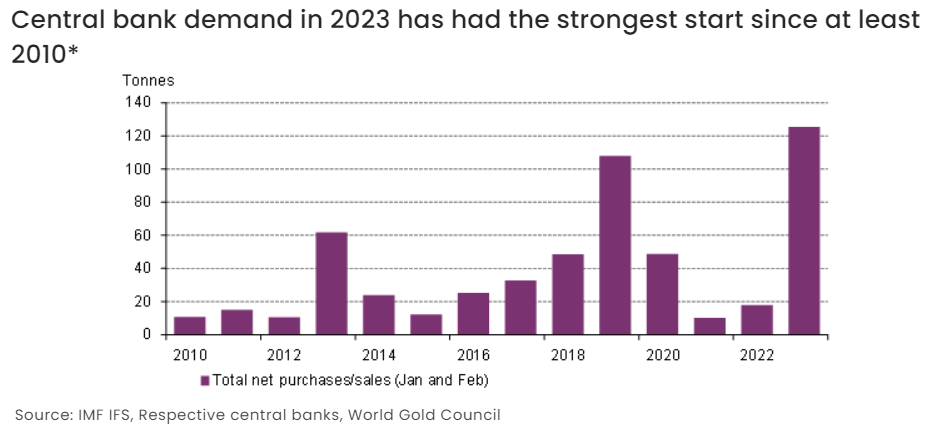
WGC reports also show The People’s Bank of China hoovered up another 15 tons of gold in January and 25 tons in February. The Central Bank of Turkey bought 46 tons during that time. And the Bank of Russia fortified its reserves by 31 tons.
This is important to note because only so much gold exists above ground.
So, like any finite asset, gold’s price may be influenced by supply and demand pressures.
Which may be precisely what’s happening now…
Because global annual gold demand soared 18% in 2022 due to “colossal central bank purchases, aided by vigorous retail investor buying,” according to the WGC.
Meanwhile, the total annual supply of gold worldwide crawled just 2% higher — significantly lower than the 18% rise in demand.
Another potential catalyst with long-term ripple effects:
As we discussed in the Gold Alliance newsletter on March 17th, the high-profile failure of Silicon Valley Bank and others “shook the world’s confidence in the US financial system.”
Investors scrambled for safety.
And by the end of March, JP Morgan analysts estimated $550 billion in funds had moved out of US banks to larger financial institutions, money market funds, bonds, cryptocurrencies… and — no surprise here — gold.
This massive loss of bank deposits could have possible long-term ripple effects on the US economy. Because falling deposits mean banks have less money available to loan.
And according to the World Economic Forum, if “ongoing banking trouble triggers a ‘sudden stop’ in lending,” it could “send the economy into the sort of recession which would go beyond what is strictly needed to tame inflation.”
To which I’ll add…
If a recession does sweep the nation, the Fed may have no choice but to start another round of QE.
And what happens to the purchasing power of the US dollar when the Fed’s printing presses roll?
I’d say more potential erosion of the dollar’s purchasing power.
Which could trigger further possible upward pressure on gold’s price as more spooked investors shift to diversifying to help protect their savings and long-term financial futures.
The list of catalysts is long.
The situation is complex and evolving.
And for all the reasons we briefly discussed today and several others we’ll examine another time…
It’s easy for me to see why so many analysts see gold rallying to record highs soon.
Yes, some of the highest estimates may look outrageous. But consider this:
If this article was penned in 2017 when gold opened at $1,075…
And I told you analysts believed gold’s price would reach a high of $2,039 by 2023…
You might think the forecast was a bit aggressive.
Yet here we are.
Gold’s price has zoomed 89.67% over the last five years. And that same five-year jump up from today’s prices would put gold near $4,000.
Now imagine if this article came out in 2007 when gold opened the year at $640…
You might have raised an eyebrow if experts predicted gold would skyrocket to $1,896 by 2011. But it did. That’s a 196% jump in five years. And that same jump up from today’s prices would put gold over $6,000.
Now rewind to 2000 when the price of gold was around $272… if someone told you gold would hit $2,039 23 years later, it might have sounded like nonsense.
But gold did rise… almost 650%.
And a jump that high from today’s prices would send gold to about $15,000.
Now, here’s the kicker:
None of those impressive gold rallies in the past happened with the massive amount of global financial turmoil you and I see today…
So, when I look back at gold’s historic performance — which I highly encourage you to do too — and I factor in the growing levels of economic uncertainty unfolding worldwide…
“Unreasonable” forecasts begin to sound a lot more plausible to my ears
Does that mean $20,000 or $50,000 gold is realistic?
Nobody can say for sure. So much can happen in the financial world over the next few years. And forecasts will shift. But if any one of those high forecasts happens and the mainstream media broadcasts the breakout to the world…
What do you think will happen when every retail investor and their neighbor catch on and rush to grab a piece of that shooting star?
As Investing.com contributor and analyst M. Schneider says, “Once metals gain more of the retail trader’s attention, can I get a P – A – R – A – B – O – L – I – C?”
————————–
Want to learn more about securing your savings with gold? Click here to get a FREE Gold Information Kit or dial toll-free 888-529-0399 now to speak with a Gold Specialist. There’s no cost and no obligation.

